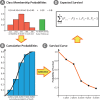Machine learning-based mortality prediction of patients undergoing cardiac resynchronization therapy: the SEMMELWEIS-CRT score
- PMID: 31923316
- PMCID: PMC7205468
- DOI: 10.1093/eurheartj/ehz902
Machine learning-based mortality prediction of patients undergoing cardiac resynchronization therapy: the SEMMELWEIS-CRT score
Abstract
Aims: Our aim was to develop a machine learning (ML)-based risk stratification system to predict 1-, 2-, 3-, 4-, and 5-year all-cause mortality from pre-implant parameters of patients undergoing cardiac resynchronization therapy (CRT).
Methods and results: Multiple ML models were trained on a retrospective database of 1510 patients undergoing CRT implantation to predict 1- to 5-year all-cause mortality. Thirty-three pre-implant clinical features were selected to train the models. The best performing model [SEMMELWEIS-CRT score (perSonalizEd assessMent of estiMatEd risk of mortaLity With machinE learnIng in patientS undergoing CRT implantation)], along with pre-existing scores (Seattle Heart Failure Model, VALID-CRT, EAARN, ScREEN, and CRT-score), was tested on an independent cohort of 158 patients. There were 805 (53%) deaths in the training cohort and 80 (51%) deaths in the test cohort during the 5-year follow-up period. Among the trained classifiers, random forest demonstrated the best performance. For the prediction of 1-, 2-, 3-, 4-, and 5-year mortality, the areas under the receiver operating characteristic curves of the SEMMELWEIS-CRT score were 0.768 (95% CI: 0.674-0.861; P < 0.001), 0.793 (95% CI: 0.718-0.867; P < 0.001), 0.785 (95% CI: 0.711-0.859; P < 0.001), 0.776 (95% CI: 0.703-0.849; P < 0.001), and 0.803 (95% CI: 0.733-0.872; P < 0.001), respectively. The discriminative ability of our model was superior to other evaluated scores.
Conclusion: The SEMMELWEIS-CRT score (available at semmelweiscrtscore.com) exhibited good discriminative capabilities for the prediction of all-cause death in CRT patients and outperformed the already existing risk scores. By capturing the non-linear association of predictors, the utilization of ML approaches may facilitate optimal candidate selection and prognostication of patients undergoing CRT implantation.
Keywords: Cardiac resynchronization therapy; Heart failure; Machine learning; Mortality prediction; Precision medicine; Risk stratification.
© The Author(s) 2020. Published by Oxford University Press on behalf of the European Society of Cardiology.
Figures







Comment in
-
The ongoing quest for improving machine learning-based risk stratification.Eur Heart J. 2020 Aug 7;41(30):2914-2915. doi: 10.1093/eurheartj/ehaa449. Eur Heart J. 2020. PMID: 32607537 No abstract available.
-
Machine learning-based mortality prediction: how to be connected to daily clinical practice?Eur Heart J. 2020 Aug 7;41(30):2913. doi: 10.1093/eurheartj/ehaa264. Eur Heart J. 2020. PMID: 32607586 No abstract available.
References
-
- Ponikowski P, Voors AA, Anker SD, Bueno H, Cleland JGF, Coats AJS, Falk V, González-Juanatey JR, Harjola V-P, Jankowska EA, Jessup M, Linde C, Nihoyannopoulos P, Parissis JT, Pieske B, Riley JP, Rosano GMC, Ruilope LM, Ruschitzka F, Rutten FH, van der Meer P; ESC Scientific Document Group. 2016 ESC Guidelines for the diagnosis and treatment of acute and chronic heart failure: the Task Force for the diagnosis and treatment of acute and chronic heart failure of the European Society of Cardiology (ESC). Developed with the special contribution of the Heart Failure Association (HFA) of the ESC. Eur Heart J 2016;37:2129–2200. - PubMed
-
- Raatikainen MJP, Arnar DO, Merkely B, Nielsen JC, Hindricks G, Heidbuchel H, Camm J.. A decade of information on the use of cardiac implantable electronic devices and interventional electrophysiological procedures in the European Society of Cardiology Countries: 2017 report from the European Heart Rhythm Association. Europace 2017;19:ii1–ii90. - PubMed
-
- Goldenberg I, Kutyifa V, Klein HU, Cannom DS, Brown MW, Dan A, Daubert JP, Estes NAM, Foster E, Greenberg H, Kautzner J, Klempfner R, Kuniss M, Merkely B, Pfeffer MA, Quesada A, Viskin S, McNitt S, Polonsky B, Ghanem A, Solomon SD, Wilber D, Zareba W, Moss AJ.. Survival with cardiac-resynchronization therapy in mild heart failure. N Engl J Med 2014;370:1694–1701. - PubMed
-
- Normand C, Kaye DM, Povsic TJ, Dickstein K.. Beyond pharmacological treatment: an insight into therapies that target specific aspects of heart failure pathophysiology. Lancet 2019;393:1045–1055. - PubMed
-
- Steffel J, Ruschitzka F.. Superresponse to cardiac resynchronization therapy. Circulation 2014;130:87–90. - PubMed
Publication types
MeSH terms
LinkOut - more resources
Full Text Sources
Medical
Research Materials

